A birdhouse or feeder can transform your backyard into a thriving bird habitat, providing essential shelter and food for various bird species. Whether you’re an experienced birder or new to the hobby, this guide will give you ideas for birdhouses and feeders that are both stylish and inviting for your feathered friends.
Birdhouses
Below are a few different types of birdhouses.
Flower Tower
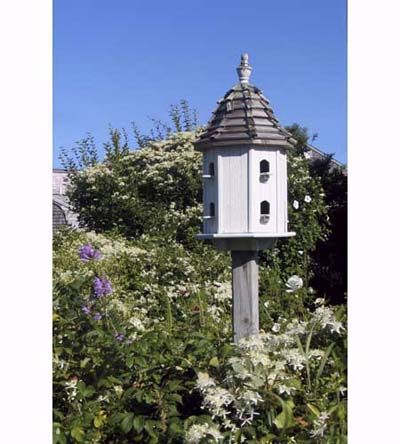
Purple Martins are prized garden visitors thanks to their knack for hunting certain pests. To attract these social birds, consider a multi-room house resembling a miniature colonial mansion. Here’s how to make it Purple Martin-friendly:
- Place the house away from trees and structures on a tall pole for predator protection.
- Paint the house white to reflect sunlight and keep it cool.
- Include a roof overhang to protect from water damage.
- Add a finial at the top to serve as a lookout perch.
Model Home
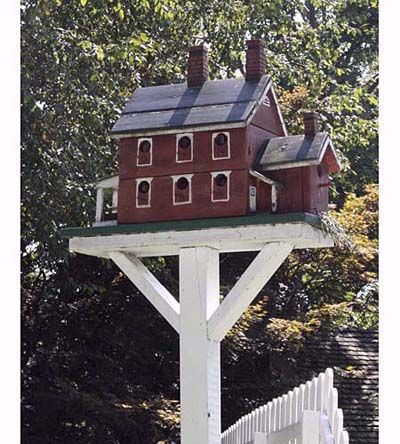
This Colonial replica birdhouse has a hinged roof for easy cleaning and maintenance, chimneys that double as perches, and multiple units to accommodate a colony of social Purple Martins.
Note that the dark exterior of this model may absorb more heat than a white birdhouse, so it could be less comfortable for the birds in hot weather. But for homes in cooler areas, the charming design can complement various garden styles.
In the Round
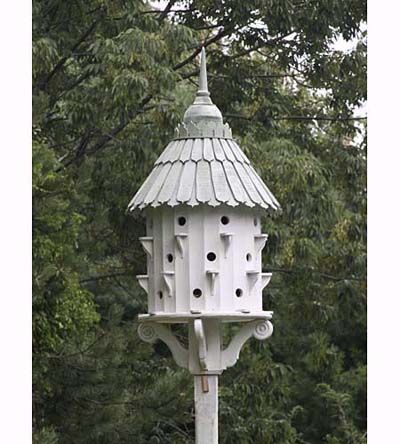
This whimsical castle-style house showcases decorative elements with multiple entrances for its avian residents. The scrolled bracket support adds an ornamental touch. However, be cautious that the threshold perches may pose a risk by offering predators like starlings and house sparrows a convenient waiting spot.
White Castle
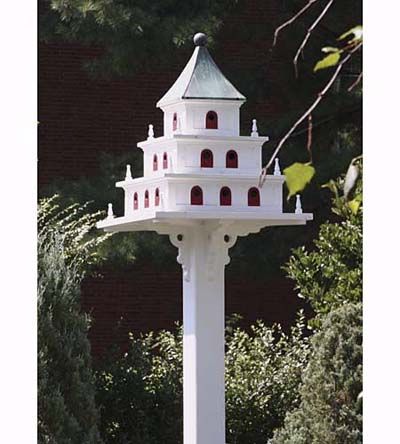
This grand three-story mansion exemplifies luxury living for birds. Its features include:
- 24 openings to house a large colony
- A copper roof for durability and weather protection
- Multiple perches, including a ball finial
- Victorian-inspired scrollwork on the stand
The white exterior helps reflect sunlight, keeping the interior cool during hot summer days. This type of elaborate birdhouse can be a great, eye-catching garden feature. The added height and open space around it make it a safe haven for birds.
Condos With Views
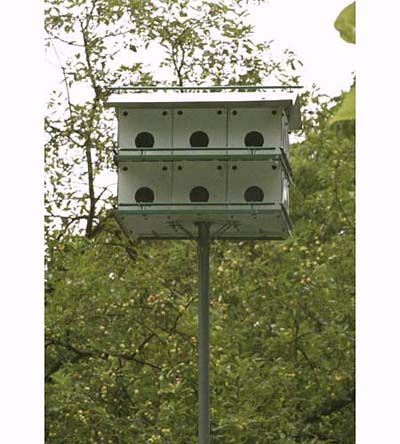
This two-story, 12-unit aluminum house is designed to attract and house a colony of Purple Martins. Key features include:
- Guard rails around each balcony to protect fledglings
- A sectioned post with pulley and lanyard for easy lowering and cleaning
- A hard-to-climb metal pole to deter predators
Aluminum construction offers durability and weather resistance, making this type of birdhouse a low-maintenance option for bird enthusiasts. The ability to lower the house for cleaning is nice since regular maintenance is fundamental to the health of the bird colony.
Tree Hugger
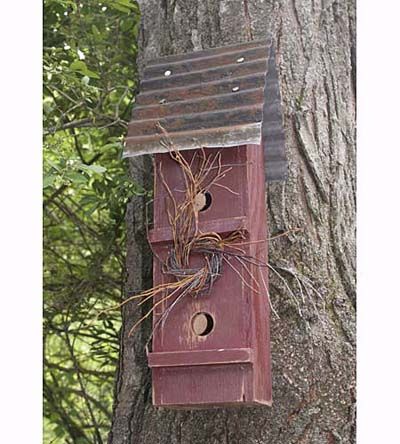
Not all birds are colonial nesters. This cozy single-family home, designed to mimic natural tree cavities, is perfect for solitary species like wrens and chickadees. Its twig camouflage provides additional protection.
To attract wrens, try placing several of these houses in your garden. Male wrens typically build multiple nests for their mates to choose from. Providing a small supply of 3-inch twigs nearby can also help the wrens build nests.
Tile and Air
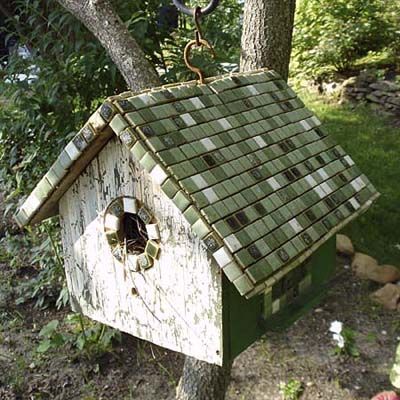
This innovative design repurposes old tiles for a durable, weather-resistant roof. It’s an eco-friendly option that may attract titmice and nuthatches when mounted on or suspended from a tree. Remember to remove old nests in late summer or fall after the breeding season to prepare the house for next year’s residents.
Picnic in the Gazebo
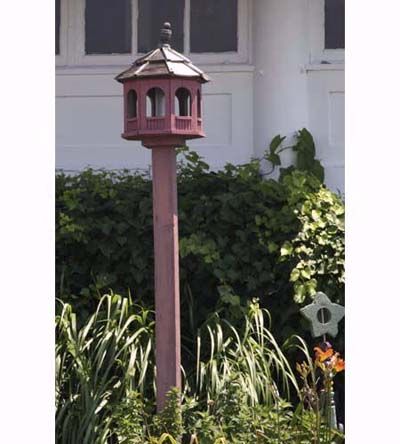
This classic red gazebo feeder is both functional and decorative. When installing this bird feeder:
- Place it far from birdhouses to avoid disturbing nesting birds
- Ensure easy access for filling and cleaning
- Surround the base with plants to conceal droppings and seed debris
Regular cleaning and maintenance of feeders prevents the spread of diseases among bird populations. Offering a variety of seeds can attract a diverse range of bird species to your yard.
American Bandstand
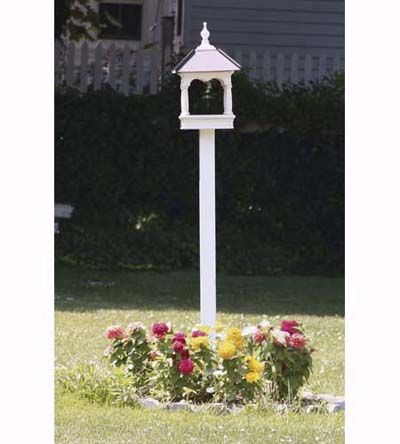
This bandstand-inspired bird feeder provides a shaded perch for songbirds and can even attract butterflies. The design of this feeder allows multiple birds to feed simultaneously. It can house several varieties of birds, making your garden a lively and entertaining destination.
When positioning a feeder like this, take the following steps:
- Place it about 4 yards from trees or structures to prevent easy access for predators
- Have a birdhouse nearby—but not too close to compromise safety
- Place it at an ideal angle from your home for optimal bird-watching
Smart Designs: Prioritizing Bird Safety and Comfort
Not all designs are equal. When designing or selecting a birdhouse, prioritize functionality and safety over decorative elements. Take a look at the examples below and learn what to keep and what to avoid when picking your new birdhouse.
Don’t
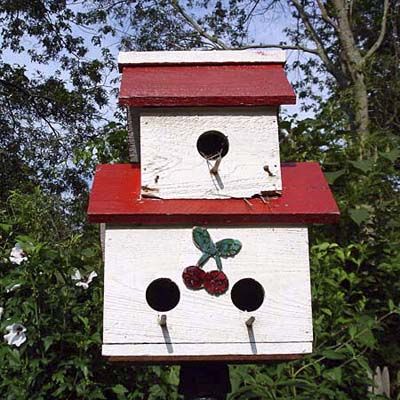
This two-story birdhouse demonstrates several design flaws that can compromise bird safety:
- Bright red roofs and reflective mosaics can attract predators
- Insufficient roof overhang fails to protect from rain and sun
- Front landing perches provide easy access for predators
Do
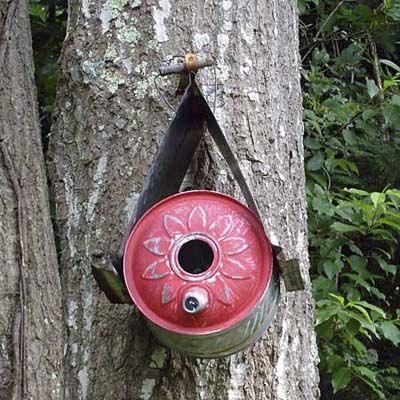
This galvanized aluminum birdhouse has several positive design elements:
- Placement in a shaded spot to avoid overheating
- A steeply pitched roof for efficient water drainage
- Use of aluminum, which provides better insulation than other metals
Don’t
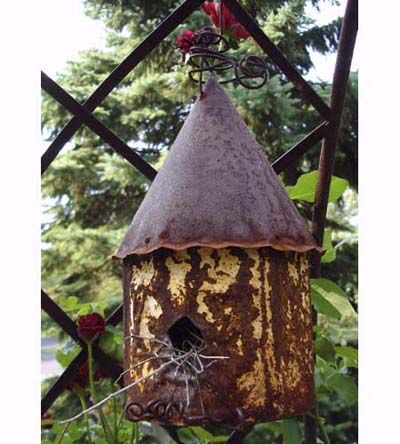
This Tudor-style metal house’s rusty patina doesn’t seem to deter nesting, as evidenced by the twigs poking from the entrance. But the twisted wire perch could pose a hazard to birds and should be removed or replaced with a safer alternative. Incorporating safer perch designs can prevent potential harm to nesting birds while keeping the structure’s charm.
Do
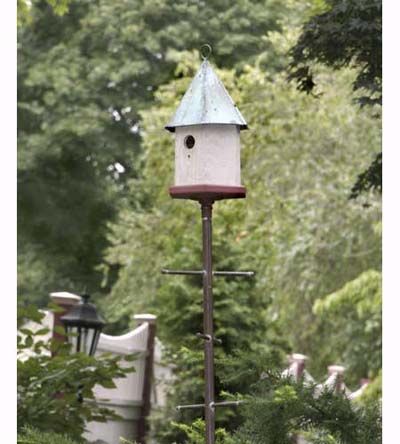
This lantern-style birdhouse incorporates several bird-friendly features:
- An oxidized copper roof for durable protection
- Multiple perches for birds to rest and socialize
- A metal pole that deters climbing predators
When using metal-roofed birdhouses, avoid placing them in direct sunlight to prevent overheating. If painting your birdhouse, choose white or light colors to reflect heat, and always use non-toxic, VOC-free paints or stains.
